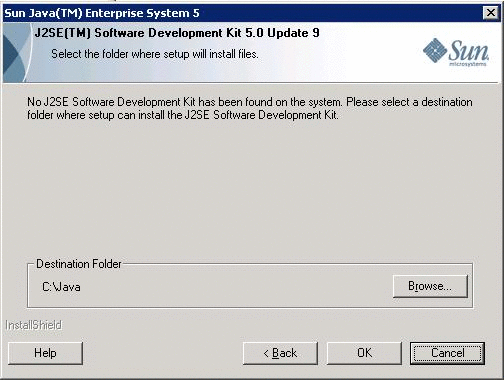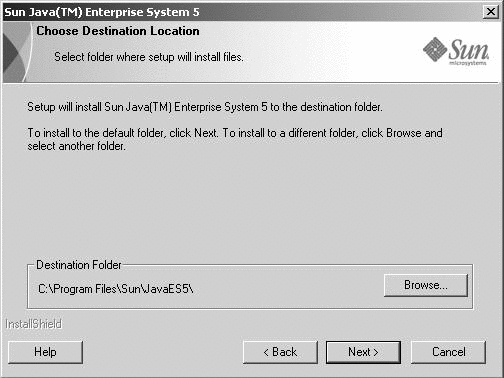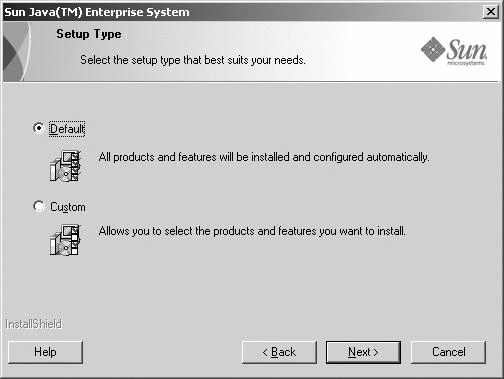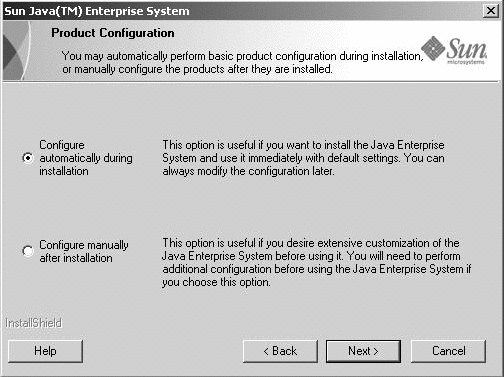Chapter 3 Installing With the Graphical Interface
This chapter provides instructions for using the interactive graphical interface to install the Sun Java Enterprise System (Java ES) software.
This chapter includes the following sections:
Verifying Prerequisites
Refer to Verifying General Installation Prerequisites for more specific information.
You can find system requirements listed in Hardware and Software Platform Information in Sun Java Enterprise System 5 Release Notes for Microsoft Windows
Running the Installer in Graphical Mode
If you have problems during installation, refer to the troubleshooting information in Chapter 8, Troubleshooting.
 To Begin Installation
To Begin Installation
-
Access the DVD drive where the Sun Java Enterprise System is mounted.
-
Click the Setup launcher to start the wizard.
Note –Run \setup.bat and NOT \Windows\setup.exe to start installation.
-
For a Download. Unzip the bits, navigate to the directory where you download the software, and click the Setup Launcher (setup.bat).
-
For DVD. Navigate to a directory the DVD drive and click the Setup launcher.
-
The Welcome page is displayed.
-
-
Click Next to continue.
The Software License Agreement page is displayed.
-
Select I accept the terms of the license agreement. Click Next.
If J2SE Software Development Kit 5.0 update 9 or above is not detected in the system, the following page enables you to specify a location to install the J2SE Software Development Kit 5.0 update 9:

Otherwise, the Choose Destination Location page is displayed:

-
Browse to a folder where you want to install the Java ES.
To keep the default location, do not make any change. Click Next.
The Setup Type page is displayed:

-
Choose the type of installation from the following:
-
Default
Choose the Default type installation if you want to install and configure all the products and features automatically at one instance.
-
Custom
Choose Custom type installation if you want to select the products and features to be installed and configuration type.
-
 To Install by Default Setup Type
To Install by Default Setup Type
-
Select the Default setup type from the Setup Type page and Click Next.
All the components are installed and configured by Default and then the Administrator Settings page appears
-
Click Next to continue.
The Administrator Settings page is displayed:

-
Type the Administrative user ID, Administrative user password, and retype the Administrative user password in the respective fields. Click Next.
Note –Though the values typed in this page are set as default values, you can modify these default settings during the postinstallation.
The Start Copying Files page is displayed. This page also confirms the component selections for this installation session.
-
The component selection page lists all the components to be installed and configured, click Next.
To make any changes to component selection, click Back and make the appropriate changes. The Setup Status page and subsequently the Installation In Progress page are displayed. The Installation in Progress page is followed by the Configuration In Progress page. This display might take some time depending on your server setup.
.
-
The Information page is displayed after the installation and configuration of the components have been completed. Click Next to continue.
The Installation Complete page is displayed.
-
Click Finish to exit the setup.
 To Install by Custom Setup Type
To Install by Custom Setup Type
-
Select the Custom set type from the Setup Type page. Click Next
The Product Configuration page is displayed as shown in the following example page:

-
Choose the type of Configuration from the following:
 To Initiate the Configure Automatically During Installation
To Initiate the Configure Automatically During Installation
Configure automatically during installation installs the components you select and configures them according to the default configuration settings. If you are new to Java ES and undecided about the configuration best suited for your need, this option is good to start with.
-
Click Configure Automatically During Installation option then click Next.
The Customize Installation page is displayed:

-
Choose the components that you want to install and configure automatically, by selecting and deselecting the check boxes. You can select some or all components:
-
Select All Components. By default all the products are selected in the Product Selection page.
-
Select Some Components. First deselect the check box next to Java ES, and then select the check box next to the components you want to install. As you make each selection, the installer automatically selects any other component that the component you selected depends on.
Each selection causes additional files to be installed, adding to more disk space required for installation. The page displays the disk space available on your host and the disk space required by the components you selected.
-
Select Install multilingual package(s) for all selected components option to install language packages.
When a web application is selected (Access Manager or Portal Server) and if no web container is selected, the web container selection page appears.
-
-
Select one of the web containers and Click OK to return to the product selection page.
-
Click Next to continue.
The Administrator Settings page is displayed.
-
Type the Administrative user ID, Administrative user password, and retype the Administrative user password in the respective fields. Click Next.
Note –Though the values typed in this page are set as default values, these default settings can be modified during the postinstallation.
The Start Copying Files page is displayed. This page also confirms the component selections for this installation session.
-
If the product selected lists all the components to be installed and configured, click Next. To make any changes to the component selection, click Back and make the appropriate changes.
The Setup Status page and subsequently the Installation In Progress page are displayed. The Installation in Progress page is followed by the Configuration In Progress page. This display might take some time depending on your server setup.
The Information page is displayed after the installation and configuration of the components have been completed.
-
Click Next to continue.
The Installation Complete page is displayed.
-
Click Finish to exit the setup.
 To Initiate the Configure Manually After Installation
To Initiate the Configure Manually After Installation
Configure Manually After Installation only installs the components you select. You need to manually configure them later. See chapter on Chapter 5, Completing Postinstallation Configuration to proceed with the configuration of the components after successful installation.
-
Select the Configure manually after installation radio button. Click Next.
The Customize Installation page is displayed.
-
You must choose the components that you want to install by selecting and deselecting the check boxes. You can select all or some of the components:
-
Select All Components. Select the check box next to Sun Java Enterprise System.
-
Select Some Components. Select the check box next to the components you want to install. As you make each selection, the installer automatically selects any other components that the component you selected depends on.
Note –You can choose to deselect installer selected components if you plan to use components installed on remote systems.
Each selection causes additional files to be installed, adding to the disk space required for installation. The page displays the disk space available on your host and the disk space required by the components you selected.
-
Select Install multilingual package(s) for all selected components option to install language packages.
-
-
Click Next to continue.
The Start Copying Files page is displayed. This page confirms the selections you made for installation.
-
The Products Selected page lists all the components to be installed. Click Next. To make any changes to component selection, click Back and make appropriate changes.
The Setup Status page and subsequently the Installation in Progress page are displayed. This display might take some time depending on your server setup.
The Information page is displayed after the installation has been completed.
-
Click Next to continue.
Note –Message Queue is automatically configured if selected. You do not need to configure message queue separately.
The Installation Complete page is displayed.
-
Click Finish to exit the setup.
After an installation session, a summary file containing the list of products installed can viewed from the installation wizard by clicking the View Summary button, or from the installation directory where this file is saved.
To Cancel Installation
You can cancel the installation by clicking Cancel. Canceling starts the uninstallation process and removes any Java ES software that is already installed.
If you selected the Configure Automatically During Installation option, you should not cancel the installation after copying files for the installation is complete and the configuration is in progress. Canceling the installation during configuration does not roll back the changes.
Next Steps
After you have completed the installation and configuration of components through the Configure Automatically During Installation option, proceed to Chapter 6, Verifying Installed Java ES Components to learn how to start and stop these components.
If you have completed the installation through the Configure Manually After Installation option, proceed to the Chapter 5, Completing Postinstallation Configuration to learn how to configure the components.
- © 2010, Oracle Corporation and/or its affiliates
